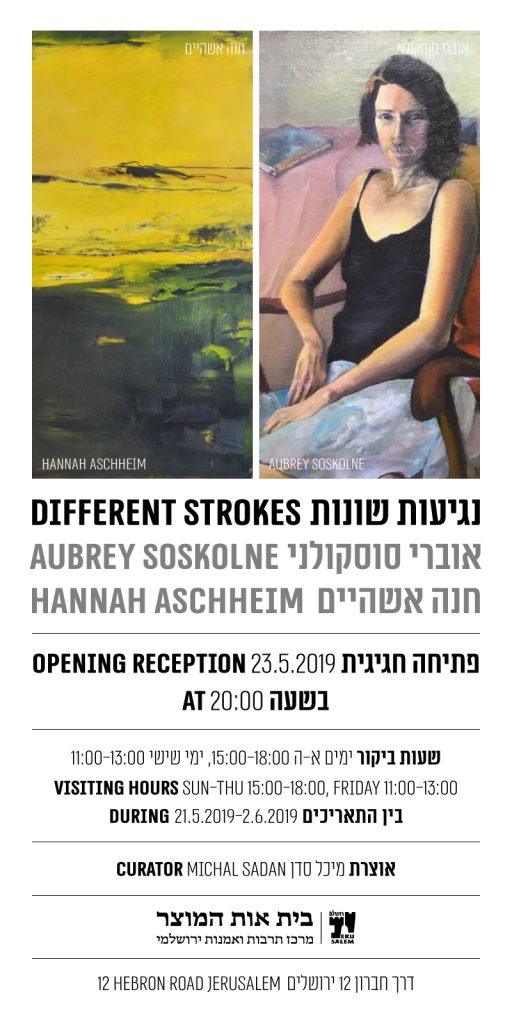Can a connection be found between realism and abstraction in art? See for yourself at a soon to be opened exhibition in Jerusalem

Sometimes we forget that the Old Masters of European painting were masters before they were old. They were masters of a trade, the trade of representing on a two dimensional medium the three-dimensional reality of their world, a world that did not include photography or video. The craft of painting required an immense commitment to master, no less so than mastering the Indian Ocean in 80 foot sailboats made of oak and hemp and canvass. The 2003 film Girl With Pearl Earring directed by Peter Webber and starring Colin Firth and Scarlett Johansson depicts the life of such an Old Master, Johannes Vermeer. While a romantic drama, the film recreates in fine detail the life and work of mid-17th century Dutch painter and to me, as a retired engineer and scientist, the interesting parts are all about the precision with which every aspect of the artist’s craft were handled.
There was a science to everything; from using basic pigments to make vibrant oil-based paints, to the preparation of the canvas, to the obsessive, almost autistic attention to the minute details of spatial projection and to finding just the right hues with which to depict each object, realizing sometimes gradual, sometimes startling, and sometimes even violent transitions between the background and the foreground of the painting. When one comes face to face with the three-dimensional object that is a Rembrandt or a Vermeer painting, one is almost startled to find that it is not only a work of representational art, but also and perhaps primarily, an engineered object, a MACHINE, one that is designed to evoke in us an immediate and forceful reaction, a machine that has been working flawlessly for centuries, never requiring anything other than light and a human eye.

Unlike the craftsmen of today, most of whom toil in the dehumanized post-industrial landscape of endless cubicles, the Old Masters lived and worked in very human spaces surrounded by children, women, men, and even livestock. Their paintings are an endless dialogue with humanity and its habitat, a dialogue that comes from a place of deep love and infinite understanding. Even the natures morts, the still lives of the Masters, with their dead ducks and fish and fruit are depictions of humanity. We can feel the touch of the artist’s hands as he arranged, so casually, but at the same time so carefully, these mundane and sometimes extraordinary objects, no doubt rearranging them them time and time again, just to get the perfect reflection of the diffuse northern light streaming from the small studio window.

There is something very Vermeer-like in the paintings of Aubrey Soskolne. His woman with the black pearl pendant is not, by any stretch of the imagination, a girl. She gazes at us with the confidence and knowledge of a woman in her prime, not the frightened look of a scullery maid caught in the act of doing something wrong. And yet both paintings share a certain detached precision, an aloofness, a challenge to ignore the electric sexuality of the woman staring at us from the canvass, a challenge that is impossible to meet. Soskolne, who has had a stellar career as a periodontist and a scientist before turning to painting full time, possesses an uncanny familiarity with the female form, a familiarity that allows him to depict his subjects in a way that packs a wallop in the rather austere package of an earth-tone palette and minor key plays with shadow and light. Soskolne’s women are alive and they make you want to be with them, or near them, forever.

The abstract works of Hannah Aschheim could not ostensibly be more different than the near realism of Soskolne’s paintings and yet they seem to bear an overwhelming affinity to them. Perhaps it is the shared palette of subdued earthy tones or perhaps it is the depth of her thick brushstrokes that fills in the details that Soskolne’s flatter paint delegates to the realism of his style, but the effect of seeing the two artists’ works side by side is one of transition from an expected juxtaposition to a startling commonality.

There is a common misconception that abstract art is somehow modern, whereas it is not all uncommon to find abstract drawings dating back to deep prehistory. This misconception stems from the Renaissance period during which Greek and Roman art was rediscovered in Europe and representational arts struggled to first equal and then extend the mastery of the ancients in realistic plasticity. During those centuries, abstract art would be an expensive folly, an indulgence that wouldn’t sell and could make the artist unemployable.

And yet, there is a deep craving in the human soul for the abstract, a craving that is impossible to define and difficult to satisfy. Great abstract art is required to be, if anything, more precise than its realistic counterpart, precisely because it has no model in the real world. Aschheim’s structured, almost architectural brushwork and palette succeed in filling in the blanks, satisfying our craving for the real, thus allowing us to step back and enjoy the abstract, the beauty of the painting as an object, distilling our experience of art to its most basic form, to the question: “is this beautiful?”

The exhibition “Different Strokes” curated by Michal Sadan in which works by Hannah Aschheim and Aubrey Soskolne will be shown side by side is opening in Jerusalem’s Beit Ot Ha’Mutzar starting on May 23rd, 2019.



